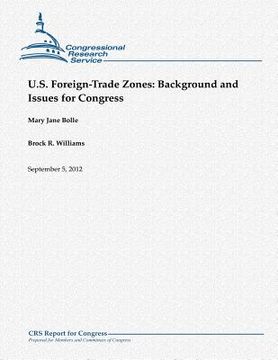U.S. Foreign-Trade Zones: Background and Issues for Congress (en Inglés)
Reseña del libro "U.S. Foreign-Trade Zones: Background and Issues for Congress (en Inglés)"
U.S. foreign-trade zones (FTZs) are geographic areas declared to be outside the normal customs territory of the United States. This means that, for foreign merchandise entering FTZs and reexported as different products, customs procedures are streamlined and tariffs do not apply. For products intended for U.S. consumption, full customs procedures are applied and duties are payable when they exit the FTZ. In 1934, in the midst of the Great Depression, Congress passed the U.S. Foreign-Trade Zones Act. It was designed to expedite and encourage international trade while promoting domestic activity and investment. The U.S. FTZ program offers a variety of customs benefits to businesses which combine foreign and domestic merchandise in FTZs. Similar types of "zones" exist in 135 countries, employing about 66 million workers worldwide. Though some aspects differ, all have streamlined customs procedures and no duties applicable on components and raw materials combined in zones and then exported. Use of the zones can facilitate cooperative international production for a substantial share of the global supply chain. U.S. FTZs can affect the competitiveness of U.S. companies by allowing savings through (1) duty reduction on "inverted tariff structures" (where tariffs are higher on imported components than on finished products); (2) customs and inventory efficiencies; and (3) duty exemption on goods exported from, or consumed, scrapped, or destroyed in, a zone. Though difficult to achieve, other possible alternatives, such as broad-based tariff reductions through multilateral negotiations, and overall customs reform might provide some of the same competitive advantages as zone use in a more efficient manner, while also ensuring that all importers have equal access. Zone activity represents a significant share of U.S. trade. In 2011, over 12% of foreign goods entered the United States through FTZs-75% of them as crude oil. Most shipments arriving through FTZs were consumed in the United States; the rest were exported. Crude oil byproducts such as gasoline, diesel, jet fuel, kerosene, and petrochemicals dominate FTZ output. Other key products include autos, consumer electronics, and machinery. U.S. zone activity occurs primarily in FTZ manufacturing "subzones." In 2012, the U.S. FTZ Board issued new regulations. They focused primarily on streamlining the application procedures and shortening, generally from a year to four months, the time for FTZ approval for manufacturing in FTZs and subzones. Congress has demonstrated a continuing interest in U.S. Foreign Trade Zones (FTZs), as they (1) may help to maintain U.S. employment opportunities and the competitiveness of U.S. producers; (2) encompass a portion of U.S. trade; and (3) affect U.S. tariff revenue. U.S. FTZs account for less than one-half of one percent of all world zone workers and a small share of the U.S. workforce. However, most of this employment is in manufacturing, which has lost a significant share of its workers over the past several decades. Today, every state has at least one FTZ, and many have numerous manufacturing subzones. Current issues for Congress relating to the U.S. FTZ program may include (1) whether U.S. FTZs encourage a misallocation of U.S. resources; (2) data availability issues; (3) security concerns; and (4) the U.S. employment and global competitiveness impact of FTZs. Broader considerations relating to the world zone network include (5) the effectiveness of trade zones worldwide as a tool for economic development; and (6) trade zones worldwide and worker rights.

